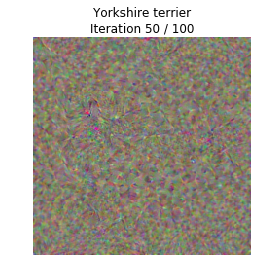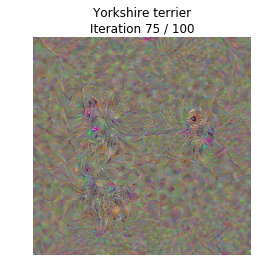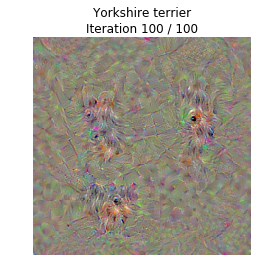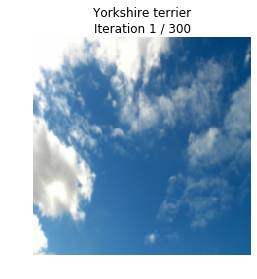基於Pytorch實現網路視覺化(CS231n assignment3)
這篇部落格主要是對CS231n assignment3中的網路視覺化部分進行整理。我使用的是Pytorch框架完成的整個練習,但是和Tensorflow框架相比只是實現有些不一樣而已,數學原理還是一致的。
在這個練習中,我們主要實現了三個部分的內容,分別是:
1. 特徵圖(saliency map)。在一個卷積神經網路中,輸入的圖片所對應的各個卷積層的輸出,就是我們通常所理解的特徵圖。它能夠用來反映圖片中那些部分是網路比較感興趣的。
2. 欺騙影象(Fooling Images)。在圖片中新增微小的噪聲,使得圖片從肉眼看上去沒啥變化,但是網路會將其分到錯誤的類別中去。
3. 類別視覺化(Class Visualization)。從噪聲圖片中還原出網路某個分類所提取到的特徵結構。這個練習稍加改動就是大名鼎鼎的Deep Dream。
那麼,練習開始。
首先是匯入庫,一些基本的函式和引數設定:
import torch import torchvision import torchvision.transforms as T import random import numpy as np from scipy.ndimage.filters import gaussian_filter1d import matplotlib.pyplot as plt from cs231n.image_utils import SQUEEZENET_MEAN, SQUEEZENET_STD from PIL import Image # %matplotlib inline plt.rcParams['figure.figsize'] = (10.0, 8.0) # set default size of plots plt.rcParams['image.interpolation'] = 'nearest' plt.rcParams['image.cmap'] = 'gray' def preprocess(img, size=224): transform = T.Compose([ T.Resize(size), T.ToTensor(), T.Normalize(mean=SQUEEZENET_MEAN.tolist(), std=SQUEEZENET_STD.tolist()), T.Lambda(lambda x: x[None]), ]) return transform(img) def deprocess(img, should_rescale=True): transform = T.Compose([ T.Lambda(lambda x: x[0]), T.Normalize(mean=[0, 0, 0], std=(1.0 / SQUEEZENET_STD).tolist()), T.Normalize(mean=(-SQUEEZENET_MEAN).tolist(), std=[1, 1, 1]), T.Lambda(rescale) if should_rescale else T.Lambda(lambda x: x), T.ToPILImage(), ]) return transform(img) def rescale(x): low, high = x.min(), x.max() x_rescaled = (x - low) / (high - low) return x_rescaled def blur_image(X, sigma=1): X_np = X.cpu().clone().numpy() X_np = gaussian_filter1d(X_np, sigma, axis=2) X_np = gaussian_filter1d(X_np, sigma, axis=3) X.copy_(torch.Tensor(X_np).type_as(X)) return X
之後匯入訓練好的模型檔案,這裡使用的是torchvision中自帶的預訓練後的SqueezeNet模型:
# Download and load the pretrained SqueezeNet model. model = torchvision.models.squeezenet1_1(pretrained=True) # We don't want to train the model, so tell PyTorch not to compute gradients # with respect to model parameters. for param in model.parameters(): param.requires_grad = False # you may see warning regarding initialization deprecated, that's fine, please continue to next steps
讀取ImageNet圖片,並展示出來:
from cs231n.data_utils import load_imagenet_val
X, y, class_names = load_imagenet_val(num=5)
plt.figure(figsize=(12, 6))
for i in range(5):
plt.subplot(1, 5, i + 1)
plt.imshow(X[i])
plt.title(class_names[y[i]])
plt.axis('off')
plt.gcf().tight_layout()下面的程式用來展示Tensor流的結構:
# Example of using gather to select one entry from each row in PyTorch
def gather_example():
N, C = 4, 5
s = torch.randn(N, C)
y = torch.LongTensor([1, 2, 1, 3])
print(s)
print(y)
print(s.gather(1, y.view(-1, 1)).squeeze())
gather_example()下面開始計算特徵圖:
def compute_saliency_maps(X, y, model):
"""
Compute a class saliency map using the model for images X and labels y.
Input:
- X: Input images; Tensor of shape (N, 3, H, W)
- y: Labels for X; LongTensor of shape (N,)
- model: A pretrained CNN that will be used to compute the saliency map.
Returns:
- saliency: A Tensor of shape (N, H, W) giving the saliency maps for the input
images.
"""
# Make sure the model is in "test" mode
model.eval()
# Make input tensor require gradient
X.requires_grad_()
scores = model(X)
loss_func = torch.nn.CrossEntropyLoss()
loss = loss_func(scores, y)
loss.backward()
grads = X.grad
grads = grads.abs()
mx, index_mx = torch.max(grads, 1)
saliency = mx.data
return saliency將提取的特徵圖顯示出來,與原圖進行比較,結果如下:
def show_saliency_maps(X, y):
# Convert X and y from numpy arrays to Torch Tensors
X_tensor = torch.cat([preprocess(Image.fromarray(x)) for x in X], dim=0)
y_tensor = torch.LongTensor(y)
# Compute saliency maps for images in X
saliency = compute_saliency_maps(X_tensor, y_tensor, model)
# Convert the saliency map from Torch Tensor to numpy array and show images
# and saliency maps together.
saliency = saliency.numpy()
N = X.shape[0]
for i in range(N):
plt.subplot(2, N, i + 1)
plt.imshow(X[i])
plt.axis('off')
plt.title(class_names[y[i]])
plt.subplot(2, N, N + i + 1)
plt.imshow(saliency[i], cmap=plt.cm.hot)
plt.axis('off')
plt.gcf().set_size_inches(12, 5)
plt.show()
show_saliency_maps(X, y)
可以看到,影象中目標物體的所在的區域能夠被特徵圖大致描述出來。這也大致直觀展示了卷積神經網路識別目標的方式。
下一部分是欺騙影象,這個方法由論文《Intriguing properties of neural networks》提出,原理是:使用梯度上升在某一類別的圖片上最大化另一類別的特徵,直到當網路將此圖片判定為另一類別的時候。下面是欺騙影象部分的程式:
def make_fooling_image(X, target_y, model):
"""
Generate a fooling image that is close to X, but that the model classifies
as target_y.
Inputs:
- X: Input image; Tensor of shape (1, 3, 224, 224)
- target_y: An integer in the range [0, 1000)
- model: A pretrained CNN
Returns:
- X_fooling: An image that is close to X, but that is classifed as target_y
by the model.
"""
# Initialize our fooling image to the input image, and make it require gradient
X_fooling = X.clone()
X_fooling = X_fooling.requires_grad_()
learning_rate = 1
##############################################################################
# TODO: Generate a fooling image X_fooling that the model will classify as #
# the class target_y. You should perform gradient ascent on the score of the #
# target class, stopping when the model is fooled. #
# When computing an update step, first normalize the gradient: #
# dX = learning_rate * g / ||g||_2 #
# #
# You should write a training loop. #
# #
# HINT: For most examples, you should be able to generate a fooling image #
# in fewer than 100 iterations of gradient ascent. #
# You can print your progress over iterations to check your algorithm. #
##############################################################################
for _ in range(100):
score = model(X_fooling)
_, index = score.data.max(dim = 1)
if index == target_y: break
target_score = score[0, target_y]
target_score.backward()
im_grad = X_fooling.grad.data
X_fooling.data += learning_rate * (im_grad / im_grad.norm())
X_fooling.grad.data.zero_()
##############################################################################
# END OF YOUR CODE #
##############################################################################
return X_fooling
完成上述程式碼後,可以執行下列程式碼來生成並展示欺騙影象:
idx = 0
target_y = 6
X_tensor = torch.cat([preprocess(Image.fromarray(x)) for x in X], dim=0)
X_fooling = make_fooling_image(X_tensor[idx:idx+1], target_y, model)
scores = model(X_fooling)
assert target_y == scores.data.max(1)[1][0].item(), 'The model is not fooled!'
X_fooling_np = deprocess(X_fooling.clone())
X_fooling_np = np.asarray(X_fooling_np).astype(np.uint8)
plt.subplot(1, 4, 1)
plt.imshow(X[idx])
plt.title(class_names[y[idx]])
plt.axis('off')
plt.subplot(1, 4, 2)
plt.imshow(X_fooling_np)
plt.title(class_names[target_y])
plt.axis('off')
plt.subplot(1, 4, 3)
X_pre = preprocess(Image.fromarray(X[idx]))
diff = np.asarray(deprocess(X_fooling - X_pre, should_rescale=False))
plt.imshow(diff)
plt.title('Difference')
plt.axis('off')
plt.subplot(1, 4, 4)
diff = np.asarray(deprocess(10 * (X_fooling - X_pre), should_rescale=False))
plt.imshow(diff)
plt.title('Magnified difference (10x)')
plt.axis('off')
plt.gcf().set_size_inches(12, 5)
plt.show()生成的結果如下所示:

我們可以看到,欺騙影象與原始影象之間的差別非常輕微,肉眼幾乎無法辨別,但是正是這種微小差異在網路進行運算之後,獲得了足夠使其誤判的特徵。
最後是類別視覺化的練習,就是通過網路學習得到的特徵,生成某一類別的影象。本質就是對一張隨機生成的噪聲圖片進行梯度上升,不過和欺騙影象的區別在於這裡在梯度中加入了正則項來使生成的圖片更有可讀性。首先是輔助函式:
def jitter(X, ox, oy):
"""
Helper function to randomly jitter an image.
Inputs
- X: PyTorch Tensor of shape (N, C, H, W)
- ox, oy: Integers giving number of pixels to jitter along W and H axes
Returns: A new PyTorch Tensor of shape (N, C, H, W)
"""
if ox != 0:
left = X[:, :, :, :-ox]
right = X[:, :, :, -ox:]
X = torch.cat([right, left], dim=3)
if oy != 0:
top = X[:, :, :-oy]
bottom = X[:, :, -oy:]
X = torch.cat([bottom, top], dim=2)
return X之後就是程式本體,在欺騙影象的基礎上加入了正則項:
def create_class_visualization(target_y, model, dtype, **kwargs):
"""
Generate an image to maximize the score of target_y under a pretrained model.
Inputs:
- target_y: Integer in the range [0, 1000) giving the index of the class
- model: A pretrained CNN that will be used to generate the image
- dtype: Torch datatype to use for computations
Keyword arguments:
- l2_reg: Strength of L2 regularization on the image
- learning_rate: How big of a step to take
- num_iterations: How many iterations to use
- blur_every: How often to blur the image as an implicit regularizer
- max_jitter: How much to gjitter the image as an implicit regularizer
- show_every: How often to show the intermediate result
"""
model.type(dtype)
l2_reg = kwargs.pop('l2_reg', 1e-3)
learning_rate = kwargs.pop('learning_rate', 25)
num_iterations = kwargs.pop('num_iterations', 100)
blur_every = kwargs.pop('blur_every', 10)
max_jitter = kwargs.pop('max_jitter', 16)
show_every = kwargs.pop('show_every', 25)
# Randomly initialize the image as a PyTorch Tensor, and make it requires gradient.
img = torch.randn(1, 3, 224, 224).mul_(1.0).type(dtype).requires_grad_()
for t in range(num_iterations):
# Randomly jitter the image a bit; this gives slightly nicer results
ox, oy = random.randint(0, max_jitter), random.randint(0, max_jitter)
img.data.copy_(jitter(img.data, ox, oy))
########################################################################
# TODO: Use the model to compute the gradient of the score for the #
# class target_y with respect to the pixels of the image, and make a #
# gradient step on the image using the learning rate. Don't forget the #
# L2 regularization term! #
# Be very careful about the signs of elements in your code. #
########################################################################
score = model(img)
loss = score[0, target_y] - l2_reg * img.norm()**2
loss.backward()
img.data += learning_rate * img.grad
img.grad.zero_()
model.zero_grad()
########################################################################
# END OF YOUR CODE #
########################################################################
# Undo the random jitter
img.data.copy_(jitter(img.data, -ox, -oy))
# As regularizer, clamp and periodically blur the image
for c in range(3):
lo = float(-SQUEEZENET_MEAN[c] / SQUEEZENET_STD[c])
hi = float((1.0 - SQUEEZENET_MEAN[c]) / SQUEEZENET_STD[c])
img.data[:, c].clamp_(min=lo, max=hi)
if t % blur_every == 0:
blur_image(img.data, sigma=0.5)
# Periodically show the image
if t == 0 or (t + 1) % show_every == 0 or t == num_iterations - 1:
plt.imshow(deprocess(img.data.clone().cpu()))
class_name = class_names[target_y]
plt.title('%s\nIteration %d / %d' % (class_name, t + 1, num_iterations))
plt.gcf().set_size_inches(4, 4)
plt.axis('off')
plt.show()
return deprocess(img.data.cpu())最後是生成影象:
dtype = torch.FloatTensor
# dtype = torch.cuda.FloatTensor # Uncomment this to use GPU
model.type(dtype)
# target_y = 76 # Tarantula
# target_y = 78 # Tick
target_y = 187 # Yorkshire Terrier
# target_y = 683 # Oboe
# target_y = 366 # Gorilla
# target_y = 604 # Hourglass
out = create_class_visualization(target_y, model, dtype)最終生成的圖片如下,從最後一副圖中可以看到一丟丟約克犬的影子:





這個東西的核心用法當然不是檢視網路提取的特徵這麼簡單,它真正的意義在於:
精神汙染
將上邊程式中的噪聲影象替換為天空影象,迭代個300代,就可以出現下面的結果:


而風格遷移也是在此基礎上進行改進而來的。下一篇部落格將CS231n的風格遷移作業進行介紹。
